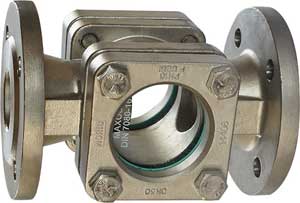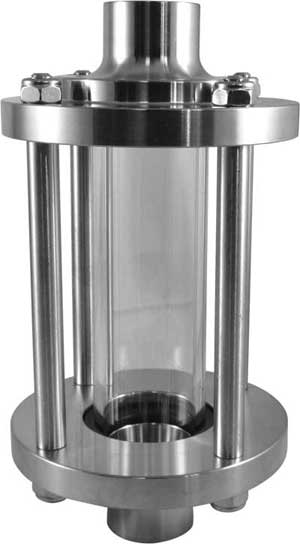What is a Sight Glass?
A sight glass, also called a control or inspection device, is a window in a pipe, vessel, tank or silo for visually observing the presence, flow or level of a medium. In this way, a device or the entire process can be checked / inspected.
The sight glasses in the piping system (inline assembly) can be supplied with various process connections such as flanges, threaded connection or welding connections.

Depending on the pressure, temperature and medium, one of the two most commonly used borosilicate or soda-lime glasses is often selected for the glass.
Please note that contrary to popular belief, every sight glass is subject to wear. That is why the glass should be checked regularly and always order replacement glass and gaskets.
If safety is compromised, you can always use double glazing. With double glazing, the glass is always designed to withstand all pressure.
Transparent media are more difficult to see. For this purpose, the following has been thought of. In a rectangular sight glass, one often uses a reflective glass. This is a glass with ribs on the inside. The refractive index of the medium makes even the clear media visible. In the other sight glasses, a flap, sphere or rotor is often used to indicate the flow of the clear transparent medium.
A sight glass can also be equipped with illumination to provide a better view into the tank or pipe.
A welded sight glass generally consists of a stainless steel or steel bottom flange (block flange, weld flange) and a rubber blanket flange, 2 gaskets and the glass. The flanges are bolted together.

Pressure
Rarely is the pressure of the medium the cause of the sight glass cracking or leaking.
Most cracks are caused by the mechanical forces on the seals and the glass.
The medium pressure on the glass is nothing compared to the pressure of the seals on the glass. Often the crack starts outside the seal. (Not directly visible)
The safety factor in the pressure is based on the medium pressure.
The pressure of the seals often exceeds the allowable long-term surface pressure.
These cracks occur slowly.
The fractures caused by the impact almost always come from the outside.
Chemical resistance
If you realistically estimate the maximum pressure, you have a chance for better resistance.
Corrosion is the most common cause of breakage and leaks.
General liquids also corrode the glass (even water).
Higher temperatures, alkalis and hydroxides separate silicon compounds. Think of drinking glasses that stop shining after a while.
Temperature, pressure and tension accelerate corrosion. That is why it is the strongest among the seals.
Pressure - Temperature
The safety factor for sight glasses is pressure, not temperature.
An increase in pressure in liquids hardly leads to an increase in temperature.
Pressure and temperature are not interdependent in liquids.
Most high temperature applications contain gases.
Pressure changes in gases also cause temperature changes.
Pressure surges therefore cause temperature shocks in gases.
At higher temperatures, the glass can very quickly withstand less pressure.
Pressure and temperature peaks can therefore not be considered independently in gases.